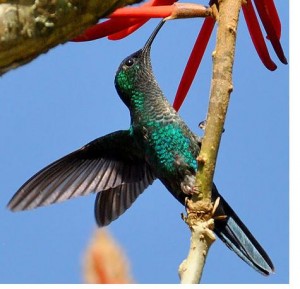THURSDAY, 9 JUNE 2011
 Some mammals filter feed vast quantities of krill out of sea water and some reptiles fire projectile tongues at unassuming insects. But research published this week in Proceedings of the National Academy of Sciences of the United States shows that hummingbirds may trump them all [1].
Some mammals filter feed vast quantities of krill out of sea water and some reptiles fire projectile tongues at unassuming insects. But research published this week in Proceedings of the National Academy of Sciences of the United States shows that hummingbirds may trump them all [1].The difficulty for hummingbirds is that their gastronomic specialization is nectar which, although calorie rich, is not the easiest form of food to transport. Zoologists have thought for years that the hummingbird tongue simply ‘sucked’ up nectar due to capillary action. The tongue has two tips, and Alejandro Rico-Guevara and Margaret Rubega have now shown that when it is projected into nectar the two ends splay out, unfurling into flattened structures. Then, as the tongue is withdrawn from the fluid, the surface tension of the liquid causes the flattened tongue tips to roll in on themselves and adhere to each other, trapping the nectar and drawing it out from the flower in 1/20th of a second.
Rico-Guevara and Rubega, who are researchers from the University of Connecticut in the United States, further reported that, although dynamic, the biomechanical process was effortless: experiments on post-mortem isolated tongues still demonstrated the ability of the hummingbird tongue to act as a ‘fluid-trap’.
Written by Nick Crumpton
